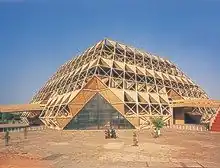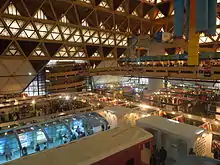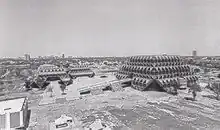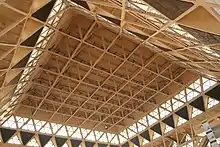
Hall of Nations was an exhibition hall that was inaugurated in 1972 as part of the Pragati Maidan complex in New Delhi, India. It was built to celebrate 25 years of the India Independence.[1]
Inaugurated by then Prime Minister Indira Gandhi for the India International Trade Fair, it was at 144 feet in length and up to 90 feet in height, and at the time, the world’s first and largest-span space-frame structure built in reinforced concrete. [2][3] It was part of group of four halls of varying sizes and each interconnected by a system of ramps. They were designed by architect Raj Rewal, who went on to win the Gold Medal of the Indian institute of Architects in 1989.[4]
The building was demolished in 2017, along with Hall No. 1 to 6, 14 to 20, state pavilions, and key neighbouring structures like the Hall of Industries and the Nehru Pavilion to make way for a new exhibition and convention centre.[1][5]
History



It was designed by the Indian architect Raj Rewal, and structurally engineered by Mahendra Raj. It was used for trade fair exhibitions.[3] The construction took 22 months, and subsequently it became the venue for the 1972 International Trade Fair. [6]
As per The Museum of Modern Art (MoMA), it was a structure "built in a time of great optimism for the future, both structures were seminal in forging a new, modern identity for Indian society and architecture. They are architectural masterpieces and important witnesses of an important chapter of Indian history."[6]
When the redevelopment plans were revealed in November 2015, it led to protest not just by local architects but also by museums like Museum of Modern Art (MoMA) in New York; the Centre Pompidou in Paris requested the government of India to consider preserving the buildings as heritage buildings.[6]
Legal interventions were still ongoing in the Delhi High Court[6] when the structure was demolished in April 2017. The demolition of the building, which was considered iconic for its architecture, led to widespread national and global disapproval.[7][8] It was described in The New York Times as a "Brutalist masterpiece" and one of the world's largest-span space frame concrete structures, when built.[9][2]
References
- 1 2 "Delhi's iconic Hall of Nations demolished". 24 April 2017.
- 1 2 "The Demolition of Delhi's Hall of Nations Reveals India's Broken Attitude to Architectural Heritage". Arch Daily. 23 June 2017.
- 1 2 Stierli, Martino (29 August 2017). "Remembering the Hall of Nations, New Delhi". MoMA post.
- ↑ "Why these buildings were reduced to rubble in 2017". Style. CNN. 5 February 2018.
- ↑ Sayer, Jason (27 April 2017). "Pragati Maidan: India flattens its iconic Hall of Nations building in New Delhi". The Architect's Newspaper.
- 1 2 3 4 "Losing A Heritage: A History of Pragati Maidan's 'Hall of Nations'". The Quint. 27 April 2017.
- ↑ Snyder, Michael (15 August 2019). "The Unexpectedly Tropical History of Brutalism". The New York Times – via NYTimes.com.
- ↑ readers, Guardian (3 May 2016). "'What were they thinking?': your favourite demolished buildings" – via www.theguardian.com.
- ↑ Katy Wong. "Why these buildings were reduced to rubble in 2017". CNN.
External links
![]() Media related to Hall of Nations at Wikimedia Commons
Media related to Hall of Nations at Wikimedia Commons